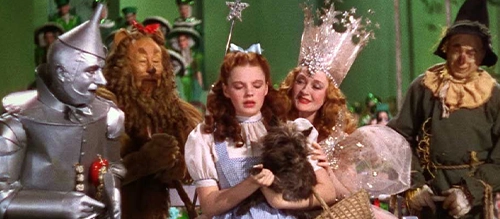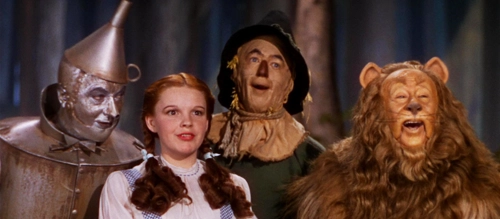The Wizard of Oz (1939) Review

The Wizard of Oz (1939)
Director: Victor Fleming
Screenwriters: Noel Langley, Florence Ryerson, Edgar Allan Woolf
Starring: Judy Garland, Frank Morgan, Ray Bolger, Bert Lahr, Jack Haley, Margaret Hamilton
No matter how many years pass since the release of The Wizard of Oz, Victor Fleming’s Hollywood Golden Era classic continues to welcome audiences new and old back to its beautifully realised Technicolour world. It is not only a timeless film whose legacy is evidently still very much alive today, but it is also particularly memorable for its impressive use of the new technology of the time and the critical acclaim it received.
The Wizard of Oz begins in a sepia-coloured Kansas, where Dorothy Gale (Judy Garland) lives on a farm with her Uncle Henry (Charley Grapewin) and Aunt Em (Clara Blandick). Dorothy decides to run away from home to protect her beloved dog Toto whose life is in jeopardy after having bitten the wealthy Almira Gulch (Margaret Hamilton). As a tornado approaches and she is unable to find shelter, Dorothy is transported to a colourful land.
In this unknown place, she meets Glinda the Good Witch of the North (Billie Burke) who explains she is now in Munchkinland in the land of Oz. To return home, Dorothy will have to embark on a mission to find the Wizard of Oz (Frank Morgan) and convince him to help her. On the way, she finds some unlikely companions: a Scarecrow (Ray Bolger) without a brain, a Tin Man (Jack Haley) who wants a heart, and a Cowardly Lion (Bert Lahr). They will help her face the threat of the Wicked Witch of the West (Margaret Hamilton) who is after Dorothy’s ruby slippers that once belonged to her sister, the Wicked Witch of the East.
Despite not being the first film to use Technicolour – that was The Gulf Between in 1917 – The Wizard of Oz remains one of the most fascinating and impressive uses of the at-the-time newly discovered technology. Most of the movie was filmed with three-strip Technicolor cameras, which, as the name suggests, captured separate colour records onto three strips of film. Although it may look unusual and perhaps even outdated to audiences today, Technicolour was revolutionary in its time as filmmakers suddenly had access to a full range of colours rather than simply utilising the limited red-green spectrum.
What is particularly interesting about The Wizard of Oz is that its use of colour is an integral part of the plot, too: the transition from the Kansas sequences to a world full of colour is still one of the most memorable moments in film history. In fact, colour defines the fantastic land of Oz, as opposed to the sepia-coloured Kansas and its characters. The Tin Man is silver, green identifies all the magical parts of Oz (such as Emerald City and the Wicked Witch of the West), and the most important objects in the whole film, the ruby slippers, are also defined by their colour.
The second most famous element of The Wizard of Oz is its musical sequences. The musical numbers are integral to the film: they are not only incredibly entertaining, with some iconic songs such as “Over the Rainbow” and “We’re Off to See the Wizard”, but they also move the plot forward, revealing key information about the characters as they sing them. The various characters are also associated with a specific tune: this is particularly true for the Wicked Witch of the West whose appearances are always accompanied by the same frightening melody.
The Wizard of Oz is the product that it is today thanks to director Victor Fleming’s contribution. Fleming was not the first choice to direct the film but, after a short period under the direction of Richard Thorpe and three days under George Cukor, Victor Fleming took over, working on most of the masterful Technicolour sequences the film is now best known for.
While Fleming’s reputation is often primarily associated with The Wizard of Oz, in February 1939 he also replaced George Cukor as the director for what would become the other film he is best known for, Gone with the Wind. As production on The Wizard of Oz was not finished yet, MGM appointed King Vidor to finish their movie (though he did not take public credit). Vidor is responsible for the sepia-coloured sequences set in Kansas, including the famous “Over the Rainbow.” When discussing the industry-changing impact of The Wizard of Oz, Vidor is rarely mentioned, but he does deserve credit for his overseeing of these key scenes.
As an award-winning film that was critically acclaimed when it came out – The Wizard of Oz went on to win three Academy Awards in 1940, out of the six it was nominated for – it is surprising that it was not incredibly profitable at the box office. Before its re-release in 1949, the movie failed to make a profit for the studio: with only $3million earned at the box office during its original release against its $2.7million budget (the most expensive MGM production ever at the time).

While it is important to acknowledge what a revolutionary film The Wizard of Oz was, it is equally important to address the behind-the-scenes controversies that came with it; primarily how it put the actors in danger. Superstar-in-the-making Judy Garland, who was only 17 at the time, was reportedly exposed to both physical and emotional abuse during the production of the film. The young actress was infamously slapped by Fleming for laughing during takes and prescribed a regular intake of amphetamines to stay awake during the day and sleeping pills at night to get her to keep up with the production schedule.
But it was not just Garland who fell victim to the studio system of the time. A lot of the special effects in The Wizard of Oz relied on actual practical effects rather than the computer-generated technology we are used to today. In the scene where Dorothy falls asleep in a poppy field, the snow that wakes her up was made out of chrysotile asbestos. Unfortunately, this was fairly common at the time, so much so that it even featured in holiday decorations, as there were still little to no asbestos regulations in the US during the period. In addition, the original aluminium-based make-up used for the Tin Man caused the first actor, Buddy Ebsen, to suffer from a lung infection. As he was hospitalized and unable to return to set, production replaced him with Jack Haley without informing the latter of the previous events. Despite switching to a different powder, the make-up still caused Haley to suffer a serious eye infection.
Behind-the-scenes controversies aside, The Wizard of Oz is to this day a very magical piece of film artistry. Part of its charm is certainly in the special effects and its use of colour, but as the novelty of technology has worn off over the decades, the movie has remained one of the greatest of all time. Part of its beauty is how everyone can find something to relate to. No matter if they are children who see the film for the first time or adults who know all the songs by heart, Fleming’s movie will always offer its viewers an escape somewhere over the rainbow. Just like for Dorothy, the land of Oz becomes a place where our imagination and dreams can be tested and ultimately come true.
It is also a fascinating representation of female characters. In a day and age when plot would often centre around male leads, something a lot of media does to this day, it is beautiful to see a film that champions female characters both as heroes and antagonists. After all, it is worth noting that the female characters are the ones that hold any kind of power in the film and move the story forward.
The Wizard of Oz is one of those once-in-a-generation movies that has forever changed the industry. More than 80 years later, its themes still resonate, reminding today’s viewers that there truly is “no place like home” as they witness Dorothy’s personal journey of growing up. Given its monumental impact on the film industry and the legacy Fleming’s movie carries to this day, it is not in the least surprising that according to the U.S. Library of Congress it is the most-seen film in history.
Score: 24/24
Written by Clotilde Chinnici
You can support Clotilde Chinnici in the following places:
Portfolio: Clotilde Chinnici
Twitter: @filmswithcloe

